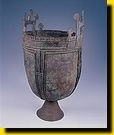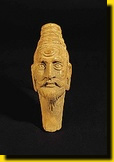|
The Silk Road: Treasures from Xinjiang
Thematic Galleries (1), (2) & (6),
Hong Kong Heritage Museum 21 December 2005 - 19 March 2006
Known as the "Western Regions" in ancient times, Xinjiang was once a communications hub between East and West, a melting pot where Chinese, Indian, Greek and Arabian cultures met and mixed. In the 2nd century BC, the imperial court of the Han dynasty sent Zhang Qian as an ambassador to visit the Western Regions, establishing China's link with that region and on to other places as far away as the coastal areas of the Mediterranean.
The Silk Road stood centre stage at that time in world history. Traversing Xinjiang, it was actively developed in the Han and Tang eras and soon became a communications network made up of several routes. Passing through various oasis statelets and across the vast expanse of the desert, it connected the routes of nomads and traders and facilitated exchanges among the major civilisations of the period. Bringing with them the products, skills, languages, customs and religious beliefs of their homelands, the traders, migrants and priests who travelled along the Silk Road helped create a rich and diverse cultural landscape in the Western Regions. It is this stunning heritage that this exhibition aims to showcase. The Leisure and Cultural Services Department is grateful to the Xinjiang Cultural Heritage Bureau for its strong support in loaning to us 115 sets of invaluable treasures collected from various museums, archaeological institutions and cultural departments in Xinjiang. Including rarely seen gold ornaments, bronze wares, wooden slips with Kharosthi script, textile products, funerary items of Zoroastrianism as well as relics of Manichaeism and Buddhism, they reveal to us the diverse cultural developments of the Western Regions in the period from the Bronze Age to the 14th century. In addition, visitors will be able to see at close range the well-preserved ancient Xinjiang mummies and a wooden corpse, exhibits that uncover the mystery of the region's ancient burial practices. With its distinctive climatic conditions, Xinjiang is one of the regions where the underground heritage has been best preserved. The legacies of Xinjiang, in particular the ancient corpses, are seldom lent out for display, as venues must meet stringent requirements regarding temperature and humidity. The exhibition is not to be missed. To enhance students' understanding of the exhibits showcased in "Treasures from the Silk Road - Xinjiang's Heritage" Exhibition, two specially designed sets of worksheets (in Chinese) will be released in December. Please call the Education Team on 2180 8260 to reserve the worksheets, which you can then collect from the Reception Counter on the date of your visit. Audio Guide Service for "The Silk Road: Treasures from Xinjiang" Enjoy some knowledgeable company on your travels along "The Silk Road: Treasures from Xinjiang"! Our new audio guide service is available in three different languages, Cantonese, English and Putonghua. You will learn more about the wonders of the Silk Road in a different and fascinating way and at your own pace. The daily rental fee for the audio guide is just HK$10. Available from 21 December 2005 – 19 March 2006 at the Audio Guide Service Counter, G/F, Hong Kong Heritage Museum. Exhibit Highlights
Other Past Exhibitions |
||||||||||||||||||||||||||||||||||||||||||






